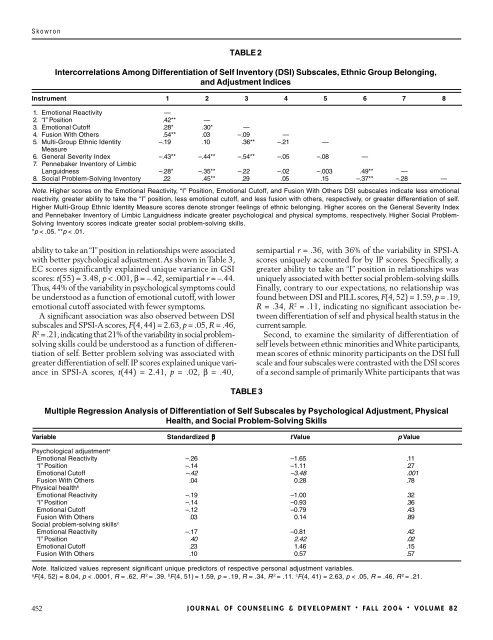Differentiation of Self, Personal Adjustment, Problem Solving, and ...
Differentiation of Self, Personal Adjustment, Problem Solving, and ...
Differentiation of Self, Personal Adjustment, Problem Solving, and ...
You also want an ePaper? Increase the reach of your titles
YUMPU automatically turns print PDFs into web optimized ePapers that Google loves.
Skowron<br />
ability to take an “I” position in relationships were associated<br />
with better psychological adjustment. As shown in Table 3,<br />
EC scores significantly explained unique variance in GSI<br />
scores: t(55) = 3.48, p < .001, β = –.42, semipartial r = –.44.<br />
Thus, 44% <strong>of</strong> the variability in psychological symptoms could<br />
be understood as a function <strong>of</strong> emotional cut<strong>of</strong>f, with lower<br />
emotional cut<strong>of</strong>f associated with fewer symptoms.<br />
A significant association was also observed between DSI<br />
subscales <strong>and</strong> SPSI-A scores, F(4, 44) = 2.63, p = .05, R = .46,<br />
R 2 = .21, indicating that 21% <strong>of</strong> the variability in social problem-<br />
solving skills could be understood as a function <strong>of</strong> differentiation<br />
<strong>of</strong> self. Better problem solving was associated with<br />
greater differentiation <strong>of</strong> self. IP scores explained unique variance<br />
in SPSI-A scores, t(44) = 2.41, p = .02, β = .40,<br />
452<br />
TABLE 3<br />
semipartial r = .36, with 36% <strong>of</strong> the variability in SPSI-A<br />
scores uniquely accounted for by IP scores. Specifically, a<br />
greater ability to take an “I” position in relationships was<br />
uniquely associated with better social problem-solving skills.<br />
Finally, contrary to our expectations, no relationship was<br />
found between DSI <strong>and</strong> PILL scores, F(4, 52) = 1.59, p = .19,<br />
R = .34, R 2 = .11, indicating no significant association between<br />
differentiation <strong>of</strong> self <strong>and</strong> physical health status in the<br />
current sample.<br />
Second, to examine the similarity <strong>of</strong> differentiation <strong>of</strong><br />
self levels between ethnic minorities <strong>and</strong> White participants,<br />
mean scores <strong>of</strong> ethnic minority participants on the DSI full<br />
scale <strong>and</strong> four subscales were contrasted with the DSI scores<br />
<strong>of</strong> a second sample <strong>of</strong> primarily White participants that was<br />
Multiple Regression Analysis <strong>of</strong> <strong>Differentiation</strong> <strong>of</strong> <strong>Self</strong> Subscales by Psychological <strong>Adjustment</strong>, Physical<br />
Health, <strong>and</strong> Social <strong>Problem</strong>-<strong>Solving</strong> Skills<br />
Variable St<strong>and</strong>ardized β t Value p Value<br />
Psychological adjustment a<br />
Emotional Reactivity<br />
“I” Position<br />
Emotional Cut<strong>of</strong>f<br />
Fusion With Others<br />
Physical health b<br />
Emotional Reactivity<br />
“I” Position<br />
Emotional Cut<strong>of</strong>f<br />
Fusion With Others<br />
Social problem-solving skills c<br />
Emotional Reactivity<br />
“I” Position<br />
Emotional Cut<strong>of</strong>f<br />
Fusion With Others<br />
–.26<br />
–.14<br />
–.42<br />
.04<br />
–.19<br />
–.14<br />
–.12<br />
.03<br />
–.17<br />
.40<br />
.23<br />
.10<br />
TABLE 2<br />
Intercorrelations Among <strong>Differentiation</strong> <strong>of</strong> <strong>Self</strong> Inventory (DSI) Subscales, Ethnic Group Belonging,<br />
<strong>and</strong> <strong>Adjustment</strong> Indices<br />
Instrument 1 2 3 4 5 6 7 8<br />
1. Emotional Reactivity<br />
2. “I” Position<br />
3. Emotional Cut<strong>of</strong>f<br />
4. Fusion With Others<br />
5. Multi-Group Ethnic Identity<br />
Measure<br />
6. General Severity Index<br />
7. Pennebaker Inventory <strong>of</strong> Limbic<br />
Languidness<br />
8. Social <strong>Problem</strong>-<strong>Solving</strong> Inventory<br />
—<br />
.42**<br />
.28*<br />
.54**<br />
–.19<br />
–.43**<br />
–.28*<br />
.22<br />
—<br />
.30*<br />
.03<br />
.10<br />
–.44**<br />
–.35**<br />
.45**<br />
—<br />
–.09<br />
.36**<br />
Note. Italicized values represent significant unique predictors <strong>of</strong> respective personal adjustment variables.<br />
a F(4, 52) = 8.04, p < .0001, R = .62, R 2 = .39. b F(4, 51) = 1.59, p = .19, R = .34, R 2 = .11. c F(4, 41) = 2.63, p < .05, R = .46, R 2 = .21.<br />
–.54**<br />
–.22<br />
.29<br />
—<br />
–.21<br />
–.05<br />
–.02<br />
.05<br />
–1.65<br />
–1.11<br />
–3.48<br />
0.28<br />
–1.00<br />
–0.93<br />
–0.79<br />
0.14<br />
–0.81<br />
2.42<br />
1.46<br />
0.57<br />
.11<br />
.27<br />
.001<br />
.78<br />
JOURNAL OF COUNSELING & DEVELOPMENT • FALL 2004 • VOLUME 82<br />
—<br />
–.08<br />
–.003<br />
.15<br />
—<br />
.49**<br />
–.37**<br />
—<br />
–.28 —<br />
Note. Higher scores on the Emotional Reactivity, “I” Position, Emotional Cut<strong>of</strong>f, <strong>and</strong> Fusion With Others DSI subscales indicate less emotional<br />
reactivity, greater ability to take the “I” position, less emotional cut<strong>of</strong>f, <strong>and</strong> less fusion with others, respectively, or greater differentiation <strong>of</strong> self.<br />
Higher Multi-Group Ethnic Identity Measure scores denote stronger feelings <strong>of</strong> ethnic belonging. Higher scores on the General Severity Index<br />
<strong>and</strong> Pennebaker Inventory <strong>of</strong> Limbic Languidness indicate greater psychological <strong>and</strong> physical symptoms, respectively. Higher Social <strong>Problem</strong>-<br />
<strong>Solving</strong> Inventory scores indicate greater social problem-solving skills.<br />
*p < .05. **p < .01.<br />
.32<br />
.36<br />
.43<br />
.89<br />
.42<br />
.02<br />
.15<br />
.57



![Solution to Exam 1, Fall '13 [PDF]](https://img.yumpu.com/21972897/1/190x245/solution-to-exam-1-fall-13-pdf.jpg?quality=85)
